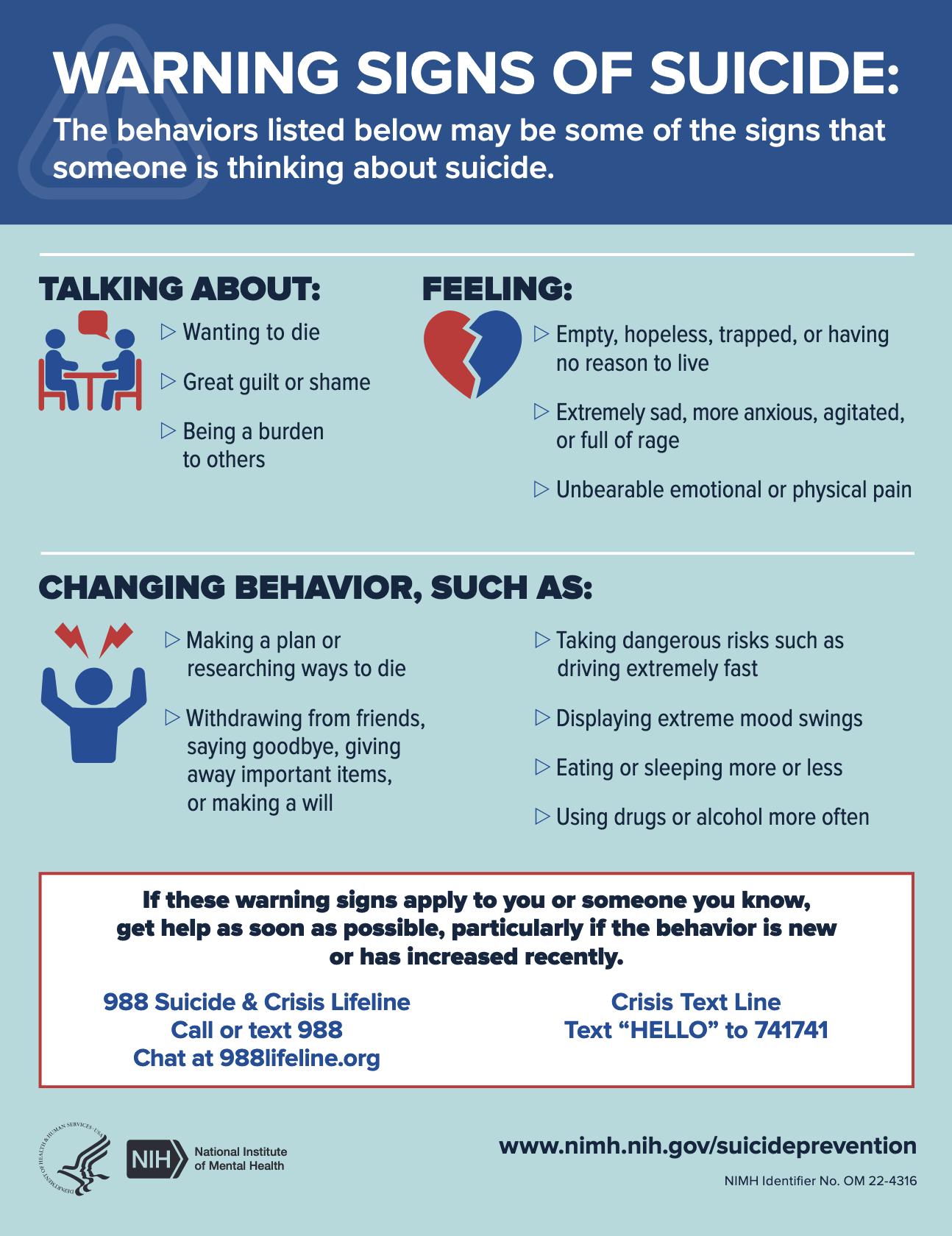How To Help Someone At Risk Of Suicide
 If you know someone struggling with despair, depression or thoughts of suicide, you may be wondering how to help. Yet many of us are afraid to do the wrong thing. In fact, you don’t have to be a trained professional to help, says Doreen Marshall, a psychologist and vice president of programs at the American Foundation for Suicide Prevention.
If you know someone struggling with despair, depression or thoughts of suicide, you may be wondering how to help. Yet many of us are afraid to do the wrong thing. In fact, you don’t have to be a trained professional to help, says Doreen Marshall, a psychologist and vice president of programs at the American Foundation for Suicide Prevention.
Here are some things you can do that can make a difference
1. Recognize the warning signs
Signs of suicide risk to watch for include changes in mood and behavior, Marshall says.
“For example, someone who is usually part of a group or activity and you notice that they stop showing up,” explains Marshall. “Someone who is usually pretty even-tempered and you see they are easily frustrated or angry.”
2. Reach out and ask, “Are you OK?”
So, what do you do when you notice someone is struggling and you fear they may be considering suicide?
Reach out, check in and show you care, say suicide prevention experts.
“The very nature of someone struggling with suicide and depression, [is that] they’re not likely to reach out,” says Marshall. “They feel like a burden to others.”
3. Be direct: Ask about suicide
“Most people are afraid to ask about suicide, because they [think they] don’t want to put the thought in their head,” says Marshall. “But there’s no research to support that.”
4. Assess risk and don’t panic: Suicidal feelings aren’t always an emergency
Say a loved one confides in you that they have been thinking about suicide, what do you do then?
For help with this conversation, psychiatrists at Columbia University have developed the Columbia Protocol, which is a risk-assessment tool drawn from their research-based suicide severity rating scale. It walks you through six questions to ask your loved one about whether they’ve had thoughts about suicide and about the means of suicide and whether they have worked out the details of how they would carry out their plan.
5. If it’s a crisis, stick around
Ask whether they have any means of harming themselves at hand and work with them to remove those things from their environment. Research shows that removing or limiting access to means reduces suicide deaths.
The National Suicide Prevention Lifeline offers this guide to the five action steps to take if someone you know is imminent danger.
If you don’t feel confident about helping someone through a crisis period, call the National Suicide Prevention Lifeline.
6. Listen and offer hope
If the person is not in immediate risk, it is still important to listen to them, say survivors of suicide attempts like DeQuincy Lezine, a psychologist and a member of the board of directors of the American Association of Suicidology. and Julie DeGolier, a medical assistant in Seattle and a survivor of suicide attempts.
“The biggest thing is listening in an open-minded way, to not be judgmental,” says DeGolier.
The next step is to offer hope, says Ursula Whiteside, a psychologist and a faculty member at the University of Washington School of Medicine. It helps to say things like, “I know how strong you are. I’ve seen you get through hard things. I think we can get through this together,” she explains.
7. Help your loved one make a safety plan
Suicide prevention experts advise people develop what’s known as a safety plan, which research has shown can help reduce suicide risk. It’s a simple plan for how to cope and get help when a crisis hits, and typically, an at-risk person and their mental health provider create it together, but a family member or friend can also help.
The American Foundation for Suicide Prevention has a template for creating a safety plan.
8. Help them tackle the mental health care system
When someone is in urgent crisis mode, it’s often not the best time to try to navigate the mental health care system, says DeGolier. But to prevent a future crisis, offer to help your loved one connect with a mental health professional to find out whether medications can help them and to learn ways to manage their mood and suicidal thinking.
A kind of talk therapy called dialectical behavior therapy, or DBT, has been shown to be effective in reducing risk of suicide.
If you or someone you know may be considering suicide, contact the 988 Suicide & Crisis Lifeline by dialing 9-8-8, or the Crisis Text Line by texting HOME to 741741.
Excerpted from “How To Help Someone At Risk Of Suicide” on NPR. Read the full article online for much more detail on each of the recommended strategies.
Listen to the podcast version of this story:






